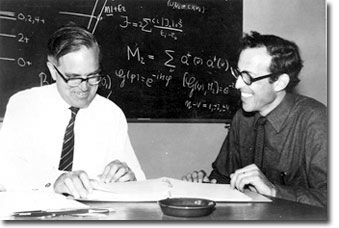The postwar period
After the war, the Niels Bohr Institute saw an enormous expansion. Postwar nuclear physics at the institute reached a high point in 1953 when Niels Bohr's son, Aage Bohr, together with the American-born physicist Ben Mottelson, proposed the collective model of the atomic nucleus, which successfully explained many otherwise bewildering experimental findings.
 After coming to Copenhagen on a stipend in 1950, Mottelson stayed on and is still working at the institute. Bohr and Mottelson shared the 1975 Nobel Prize in physics for their work with another American physicist, James Rainwater.
After coming to Copenhagen on a stipend in 1950, Mottelson stayed on and is still working at the institute. Bohr and Mottelson shared the 1975 Nobel Prize in physics for their work with another American physicist, James Rainwater.
From the mid-1950s the Niels Bohr Institute played a pioneering role in reopening contact between East and West during the Cold War. The institute's reputation for high-quality research and its international orientation, as well as preexisting contact with physicists in the Soviet Union, were instrumental for the reestablishment of formal and informal cooperation, ending a period of Soviet isolation extending from well before the war.
In the 1950s the institute also involved itself in the thriving field of high-energy particle physics. The interest in this field was inspired by the theoretical physics group of the European Organization for Nuclear Research, CERN, which was located at the institute from its establishment in 1952 until 1957, when the group joined the rest of CERN outside Geneva, Switzerland. By this time, the institute had developed its own activities in the field and the institute is today involved in several large research projects at CERN's accelerator facilities.
Over the last few decades many other fields of physics, such as chaos theory, quantum optics and biophysics, have developed. Such fields constitute a considerable part of the institute's present activities. Since 1993 teaching and research have expanded further, in that solid state physics, geophysics and astronomy have been incorporated into a larger Niels Bohr Institute.
Finn Aaserud, historian of science, director of the Niels Bohr Archive
